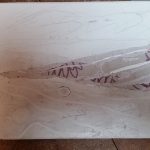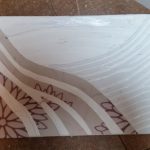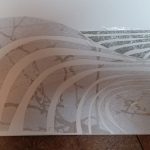I’ve been unable to do any printing for quite a while. I have been plagued with problems with my foot, putting me on crutches since mid-November. I used my down time looking at a lot of pictures, but also thinking about subjects and themes. I’ve been interested in neolithic rock art for some time now and living near Avebury and Stonehenge it’s impossible to avoid standing stones. Scattered also across the landscape of Wessex are hundreds, if not thousands of barrows and burial mounds and of course the White Horses like Pewsey, Cherhill, Westbury etc in Wiltshire or Uffington in Oxfordshire. In addition we have the famous Cerne Abbas Giant, the Long Man of Wilmington and assorted other hill figures, many now lost completely.

It isn’t just Britain with these features. The stone alignments of Carnac in Brittany are well known, but there are a multitude of standing stone circles, alignments and dolmens across France and Ireland and much further afield.
Putting all this together made me wonder about the sort of landscape we might see if more had survived. Out of that has evolved the print series I’m putting together. This will take landscapes, more or less stylised and incorporate into them other figures. I will draw on a range of sources. I’m researching Celtic and Saxon myths, cave paintings as well as the sort of abstract shapes found in rock art.
Technically, these prints will incorporate collagraph and dry point plus perhaps solar etching and ultimately hand embellishments. I also expect to use monoprinting or hand painting as the ground on which the prints will be made. I’m also going to try and incorporate some of the techniques used by Australian artist, Kim Westcott. (http://www.kimwestcott.com, although the site did not load properly for me.) She reuses old plates in combination with new, mixing in shadow prints and rotation of the plates to create her drypoints.
I have no prints as yet, but here are some rough sketches and photos of some plates in preparation.
With luck, I’ll have more over the next few weeks.
***
I’m not the only one finding inspiration in these themes. See the web pages for Irish artist Tommy Barr.
http://tbarrart.homestead.com/index.html











